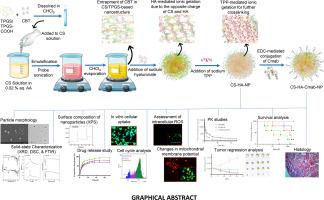基于壳聚糖/透明质酸的西妥昔单抗功能化纳米颗粒负载卡巴他赛,通过空间靶向增强了在大鼠 DMBA 诱导的乳腺癌模型中的抗肿瘤疗效
IF 3.8
Q2 CHEMISTRY, PHYSICAL
引用次数: 0
摘要
文章讨论了阳离子壳聚糖(CS)与阴离子透明质酸(HA)钠盐的离子凝胶化作用,以形成 125 纳米的纳米颗粒。这些颗粒进一步用西妥昔单抗进行了功能化,使其具有空间靶向过度表达表皮生长因子受体的肿瘤的能力。利用 XRD、傅立叶变换红外光谱和 DSC 对颗粒进行的固态表征显示,在无定形纳米结构中负载的卡巴齐他赛形成了稳定的纳米颗粒。用于评估表面特性的 XPS 研究表明,西妥昔单抗已成功地固定在颗粒表面。由于基质中含有 CS,制备的 CS-HA-Cmab-NP 具有 pH 值响应的药物释放行为。在 MDA-MB-231 乳腺癌细胞系上对纳米粒子的体外性能进行了评估,结果表明纳米粒子的药效全面提高。在雌性 Sprague Dawley 大鼠体内进行的药代动力学和抗肿瘤效果评估表明,Cmab 共轭纳米粒子改善了卡巴他赛的半衰期和肿瘤缩小能力,提高了存活率,降低了体重。结果表明,锚定西妥昔单抗的 CS/HA 纳米粒子通过空间靶向作用,在 DMBA 诱导的乳腺癌模型中具有更强的减小乳腺癌肿瘤的功效,从而降低了全身毒性。本文章由计算机程序翻译,如有差异,请以英文原文为准。

Cetuximab functionalized chitosan/hyaluronic acid-based nanoparticles loaded with cabazitaxel enhances anti-tumor efficacy in DMBA-induced breast cancer model in rats through spatial targeting
The article discusses the ionic gelation of cationic chitosan (CS) with anionic hyaluronic acid (HA) sodium salt to form nanoparticles in the range of 125 nm. The particles were further functionalized with cetuximab to endow it with the ability to spatially target the tumor over-expressing EGFR. Solid-state characterization of the particles using XRD, FTIR, and DSC revealed the formation of stable nanoparticles with Cabazitaxel loaded in the amorphous nanostructure. XPS study used to assess the surface characteristics indicated that the cetuximab was successfully anchored on the surface of the particle. The prepared CS-HA-Cmab-NP elicited a pH-responsive drug release behavior due to the presence of CS in the matrix. In vitro performance of the nanoparticles was evaluated on MDA-MB-231 breast cancer cell lines showed overall increase in efficacy. In vivo pharmacokinetic and anti-tumor effect evaluated in female Sprague Dawley rats indicated that the Cmab-conjugated nanoparticles improved half-life of cabazitaxel and tumor reduction capability with higher survival rate and lower reduction in body weight. The results indicate that CS/HA nanoparticles anchored with cetuximab show enhanced efficacy in reducing the breast cancer tumor in DMBA-induced breast tumor model through spatial targeting, consequently reducing the systemic toxicity.
求助全文
通过发布文献求助,成功后即可免费获取论文全文。
去求助
来源期刊

Chemical Physics Impact
Materials Science-Materials Science (miscellaneous)
CiteScore
2.60
自引率
0.00%
发文量
65
审稿时长
46 days
 求助内容:
求助内容: 应助结果提醒方式:
应助结果提醒方式:


